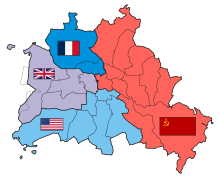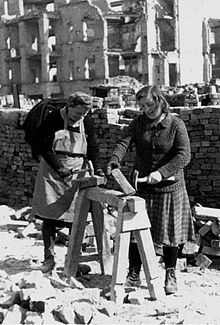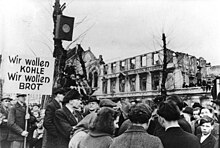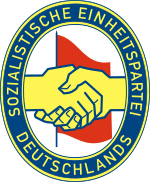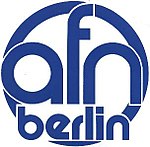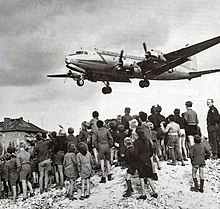Germany 1945 to 1949
| Germany 1945–1949 |
|||||
|---|---|---|---|---|---|
|
|||||
|
|||||
| Capital and administrative headquarters |
Berlin ( de jure ) Frankfurt am Main ( American zone ) Bad Oeynhausen ( British zone ) Baden-Baden ( French zone ) East Berlin ( Soviet zone ) Haren ( Polish zone , until 1948) |
||||
| Governance | Allied Control Council | ||||
| currency | Western and Eastern Zone: Reichsmark and Rentenmark (1945–1948) Western Zone: Deutsche Mark (1948–1949) Eastern Zone: German Mark (1948–1949) Saarland: Saar-Mark (1947), French Franc (1947–1949) |
||||
| Time zone |
CET EET |
||||
| License Plate | D. | ||||
| Map (excerpt) | |||||

|
|||||
The occupation time in Germany between 1945 and 1949 was the phase between the end of the Nazi regime and the Second World War and the establishment of the two German states, the Federal Republic of Germany and the GDR , which belonged to two competing power blocs during the Cold War .
The situation after the end of the war

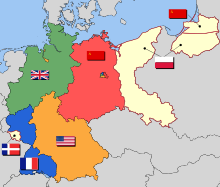
The historian Lutz Niethammer counts the years from the unconditional surrender of the Wehrmacht and the defeat of the German Reich to the reorganization or the founding of two German states as parts of the German nation and thus the beginning of the 40-year history of German division as the "most complicated sections of the German history […], an interdependent process in which all world powers were involved ”.
Situation before the occupation
The state organization of the German Reich was no longer fully functional even before the "collapse". After the victorious powers dissolved the Supreme Reich Authorities and the National Socialist German Workers' Party (NSDAP), the population and subordinate administration were largely relegated to self-organization. Long in exile , in 1945 Thomas Mann described the Germans as "this unfortunate people". The westward migration of 12 to 14 million displaced persons and refugees and the collapse of the German economic areas aggravated the social misery.
Allies take over government
Based on its territorial status from 1937 , occupied Germany was divided up. This happened at the decision of the Allies at the Yalta Conference (February 2-11, 1945). The eastern areas ( Oder-Neisse areas ), which made up around a third of the national territory, had been handed over to the People's Republic of Poland or to the Russian SFSR as one of the Union republics of the Soviet Union for administration by the Soviet Red Army . The Russian SFSR administered the northern part of East Prussia , which today belongs to Russia , the remaining eastern areas have been administered by Poland since 1945 and are now part of Poland .
The remaining two thirds of the national territory - with the exception of Berlin and a few small areas on the western border - were divided into four zones of occupation:
- American zone of occupation
- British zone of occupation
- French zone of occupation
- Soviet occupation zone
On June 5, 1945, the Commander-in-Chief of the Four Powers ( USA , Great Britain , France and the Soviet Union ) assumed supreme governmental power over the whole of Germany through the Berlin Declaration . This lay with the Allied Control Council based in Berlin .
For Greater Berlin there was a joint occupation by the Allies and the establishment of the Allied Command for the administration of the urban area, whereby the city itself was also divided into four sectors , each of which was subject to an Allied occupation regime.
The British and the US-Americans evacuated Saxony , Thuringia and parts of Mecklenburg , only to leave them under Soviet control on July 1, 1945. In return, they and France received the three western sectors of Berlin . On July 10th, French occupation troops entered Saarland , which the US troops had left.
The first countries were established in July 1945 in the Soviet zone of occupation; However, the Soviet Union pursued a unitary state in which the countries should only be administrative units. The British also organized their zone in north-west Germany in a more centralized manner. The Americans, on the other hand, pursued a federalist concept in southern Germany , according to which the states should also play an important political role.
In the Atlantic Charter , the Casablanca Conference , the Tehran Conference and the Yalta Declaration , the Allies had worked out the various strategies in some cases as early as 1943, when a foreseeable victory over National Socialist Germany was assumed. Nonetheless, the changeable results of the occupation policy were viewed by the occupying powers as well as by the Germans as temporary arrangements for a long time . It was only with the formation of a bloc in the Cold War that the preliminary - especially the division of Germany - became apparently final.
conference of Potsdam
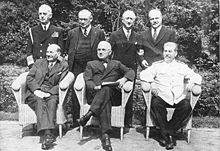
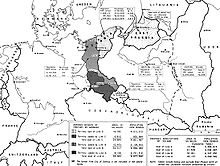
In mid-July, Winston Churchill , Harry S. Truman and Josef Stalin were in Germany to discuss how to proceed in a three-power conference of the main Allies at the highest level. The most important results were decided on August 2, 1945:
- the democratization of Germany
- the decentralization of its economy
- the establishment of a joint control council for Germany as an organ of joint occupation of the victorious powers, which u. a. should preserve the unity of Germany as an economic area
- the demilitarization of the country
- the denazification ( denazification ) of the Germans
- the establishment of an international military tribunal (see Nuremberg Trials )
- the de facto separation of the areas east of the Oder-Neisse line by placing them under temporary Polish administration
The demand for a “balanced economic life in all of Germany” soon became obsolete due to the divergence in economic conditions in the occupied zones (also a consequence of the increasing confrontation between the political blocs in the Cold War ).
The conference caused a first scandal with the United States of America about the Soviet reparation demands . The Allies celebrated the celebrations for the victory over Japan together in front of the Brandenburg Gate . In September 1945, with the Wanfried Agreement, a minor exchange of territory between the American and Soviet zones of occupation was agreed.
Prisoners of war
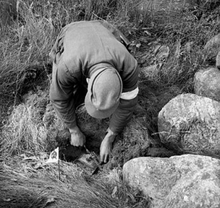
A total of eleven million German soldiers were in captivity in 1945, five million of whom were released again very quickly. In the last few weeks before the end of the war, four million German soldiers surrendered to the Americans alone. The Americans had serious logistical problems in adequately supplying this huge number of prisoners of war with food, medicine and shelter. Finally, in the spring of 1946, the ICRC was allowed to hold visits and provide limited amounts of food to prisoners of war in the American Zone. ( For Germans in American custody in 1945, see Rheinwiesenlager .)
The United States made over 700,000 prisoners of war available to the French to rebuild their country. France forced around 50,000 into high-risk forced labor as deminers . Some had to work in harsh mining conditions. Many were only able to return home in 1948. For those in Soviet captivity, the prospect of survival was poor - around 30 percent died. The last came back to Germany only in 1956, the so-called homecoming of the ten thousand .
Rubble and culture women
On May 29, 1945, all women between the ages of 15 and 65 were required to register in Berlin. Working as a “ rubble woman ” brought in better ration cards . Women, who bore the brunt of the reconstruction in German cities in the first post-war years , developed a new self-image and self-awareness during this time. In the countryside there were so-called culture women , tree planters who reforested the forests that had been destroyed by bombs or cleared for firewood. A memorial was placed on the old 50 pfennig coin .
The more conservative climate of the later years under Federal Chancellor Konrad Adenauer was to largely push back the emancipatory approaches - at least in West Germany . In the course of the economic upturn in West Germany, the number of women forest workers fell drastically. Many migrated to the newly built factory halls. For example, while in 1953 over 200 women were still employed in the Crailsheim Forestry Department, their number was less than half in 1963, and in 1987 there were only three women forest workers. In the first German Bundestag in 1949, women were proportionally less represented than in the Reichstag of the Weimar Republic .
economy

Food supply
The general food supply was poor and there was not enough to eat. Many people died of hunger or thirst in the first few weeks after the war - especially infants and toddlers - because there was no milk. The average supply per day reached z. B. in Bavaria just 1000 kcal. The “Cooperative for American Remittances for Europe” ( CARE ) sent care packages , but until June 5, 1946 it was forbidden to send CARE packages to Germany. As part of the punishment philosophy, US troops were banned from providing aid, particularly food, to hungry Germans. American households in occupied Germany were instructed not to give leftovers to German domestic workers; all excess food had to be destroyed or made inedible.
The allied occupying powers issued new food cards in their respective sectors, which were classified according to the severity of the work in consumer groups (categories) from I to V. The rations given out were redefined every week according to the possibilities.
Dismantling
In the Soviet Occupation Zone (SBZ), the reparation measures focused on intensive industrial dismantling: after all, the USSR had to bear the brunt of the fight against National Socialist Germany - almost 22 million Soviet civilians and soldiers died during the war.
The dismantling in the factories was carried out by the workers who had often worked on the machines for years. Out of natural aversion to these measures, it was repeatedly "forgotten" to pack the individual parts necessary for operation. This meant that further use was usually ruled out during a reconstruction in the Soviet Union. Therefore, the on-site dismantling was stopped early, the suitable companies were transferred to Soviet joint-stock companies and the “checked” finished products were then transported away as reparations.
From 1945 to the end of 1946 alone, 1,000 businesses were dismantled, and by March 1947 almost 12,000 kilometers of rails were dismantled. The conversion to a planned economy began in spring 1948 with the German Economic Commission (DWK) . In contrast to the practice in the three western occupation zones (→ Trizone ), “ denazification ” in the Soviet Zone also served for massive expropriations and social redistribution and restructuring ( land reform from September 1945, among others). Nevertheless, the GDR, which emerged from the Soviet zone, was to develop into one of the more prosperous countries of the Eastern Bloc , which, however, always lagged behind the economic level of the Federal Republic of Germany .
Dismantling also took place in the western occupation zones. They were started according to an industrial plan drawn up in March 1946, according to which 1,500 factories were to be dismantled in order to reduce production levels to around 50 percent from 1938. On June 13, 1949, Belgian soldiers took action against German workers who tried to use barricades to prevent the dismantling of a hydrogenation plant .
After the Second World War, the Ruhr question was again on the political agenda. The Ruhr Statute established an International Ruhr Authority in Düsseldorf on April 28, 1949 . The aim was to control West German heavy industry by limiting production and deciding how much coal and steel Germany could get itself and how much of it was to be exported. The dismantling plans were last revised in the Petersberg Agreement of November 22, 1949. In January 1951 the dismantling was finally finished.
The total value of the dismantled facilities is estimated at up to DM 5.4 billion for West Germany and up to DM 5 billion for the Soviet occupation zone and the GDR.
reconstruction
Western zones

There was no real “ zero hour ” for the German economy: Germany was by no means entirely in ruins. The historian Niethammer puts it coolly: “ [...] on the balance sheet, the bombers did not wipe out German industry, but shaved off their expansion during the war, the loss of people and qualifications during the war was due to the influx from the east and the willingness to perform elementary subsistence level depressed population more than balanced. "
On September 6, 1946, the US Secretary of State James F. Byrnes gave the speech of hope in Stuttgart , thereby announcing the bizone . In this speech he also rejected the peace possibilities of the Morgenthau Plan of 1944. American policy changed as a result. The JCS 1067 directive, which has been in force since April 1945 , stated that the military governors were not allowed to take any steps "that (a) could lead to the economic reconstruction of Germany or (b) are suitable for maintaining or strengthening the German economy." from 1946 applied only in a weakened form. On the initiative of Lucius D. Clay , Lewis H. Brown prepared the A Report on Germany with restructuring recommendations, which also called for the replacement of the JCS 1067 directive and the remnants of the Morgenthauschen ideas contained therein. This happened in July 1947. In mid-1947 US Secretary of State George C. Marshall presented his economic development program for Europe at Harvard . Now it was said: "For an orderly and flourishing Europe, the economic contributions of a stable and productive Germany are just as necessary as the restrictions that are intended to guarantee that destructive militarism cannot revive in Germany."
In this context, West Germany received approximately 1.4 billion US dollars from the USA from 1948 to 1952 . The measures of the Marshall Plan also took effect in Germany, although this effect was more psychological than purely material. In 1953 it was decided that the Federal Republic of Germany had to repay around 1.1 billion US dollars.
To revive the housing and the necessary creation of housing for refugees and displaced persons was 1949, the first systematic, uniform (to date largest) and centrally controlled housing program in West Germany after the war, the ERP Special Program " construction of 10,000 refugee dwellings " at the initiative of the German trade unions with 40 million marks realized from Marshall Plan funds in Schleswig-Holstein. The foundation stone of the special program was laid on March 5, 1950 by Hans Böckler , who died on February 16, 1951 , in the settlement later named after him (" Böcklersiedlung ") in Neumünster as the largest single building project of the special program. The laying of the foundation stone for this first project of the special program on the large construction site in Neumünster is therefore considered to be the structural beginning of systematic social housing construction in the Federal Republic of Germany after the Second World War.
The cost of the occupation of over 2.4 billion US dollars per year was transferred to West Germany.
Over a period of two years, the USA took all German patents and industrial secrets for itself, according to Professor John Gimbel in "Science Technology and Reparations: Exploitation and Plunder in Postwar Germany" at a value of almost 10 billion US dollars. The British also seized business secrets by kidnapping German scientists and technicians and interning German business people if they did not want to disclose their business secrets. Adenauer wrote that the damage to the German economy was very high and could hardly be quantified. The seized devices contained electron microscopes, were among other things. a. Cosmetics, textile machines, tape recorders, insecticides, a unique chocolate packing machine, a manure shaker, ice skate grinder, paper napkin machines, and other technologies, almost all of which were either adopted into United States industry or superior in quality to American products. According to Adenauer, according to a statement by an American expert, IG-Farben's patents had given the US chemical industry a head start of at least ten years.
Project Safehaven was an American program, parallel to Operation Overcast (including Operation Paperclip ), to hinder German research and to prevent German researchers from emigrating to countries like Spain or Argentina . The US armed forces concentrated on Saxony and Thuringia. Many Berlin research institutions had been evacuated there. By 1947, Project Safehaven had captured an estimated 1,800 technicians and scientists, along with 3,700 family members. They were detained for three years in rural areas with no work or research facilities. According to John Gimbel, the USA put some of the best minds in Germany on hold for three years, thereby robbing the German reconstruction of its competence.

The Volkswagen plant in Wolfsburg built for the production of the " KdF-Wagons " was to be dismantled and shipped to Great Britain. But no British manufacturer was interested in the plant and its product: "The vehicle does not meet the basic technical requirements for an automobile [...], it is rather unattractive for the average buyer [...]". It is uneconomical for the company to build the car commercially.
Under British administration, almost 2,000 VW Beetles were built in 1945 in the Wolfsburg Motor Works despite supply bottlenecks and the destroyed transport infrastructure ; the following year there were already around 10,000 vehicles. About a quarter of the cars were exported. VW soon replaced Opel as the largest German automobile manufacturer.
By 1950, the gross national product of 1936 had already been reached again in the west .
Soviet occupation zone
The German Economic Commission coordinated economic reconstruction in the Soviet occupation zone . It ensured the reparation payments to the Soviet Union and operated the establishment of a socialist planned economy . When a currency reform also took place in the Soviet Zone a few days after the West German currency reform , this meant the end of an all-German currency.
By spring 1948, 9,200 companies had been expropriated without compensation, which was 40% of gross production in the Soviet Zone.
The supply of the population with food was initially better than in the west, but deteriorated as a result of the land reform , since many of the newly created smallholder positions, where refugees and displaced persons were often settled, could not start satisfactory production.
The lower damage caused by direct effects of the war was offset by the disproportionately higher reparation damage. While only around 5 percent of the fixed assets from 1944 were dismantled in the western zones , this proportion was between 30 and 50 percent for the Soviet Zone. Including the cost of the occupation, the Soviet reparations amounted to approximately $ 12.2 billion.
Press
Allied troops published newspapers in all the occupied areas in order to provide the population with important information (see Army Group Press ). Other newspapers had to be licensed in the Western Zones until the late 1940s. This was to prevent National Socialists or other anti-democracy opponents from becoming active as a journalist (see licensed newspaper ). In East Germany , the Soviet Military Administration in Germany (SMAD) ensured that the publications were loyal to the line by allocating material. Only sheets close to the KPD / SED received sufficient printing paper.
The " Aachener Nachrichten " has been published since January 24, 1945, making it the longest uninterrupted newspaper in Germany. The first license from the American military administration was awarded to the “ Frankfurter Rundschau ” on August 1, 1945 . The " Süddeutsche Zeitung " first appeared on October 6, 1945 in Munich , albeit initially only twice a week with only four pages. The license for the “ Hörzu ” program guide was a factor in the rise of Axel Springer Verlag . The first edition of " Neues Deutschland " appeared in April 1946 in the eastern sector of Berlin . " Die Welt " and " Die Zeit " have been published since 1946, " Der Spiegel " since the beginning of 1947.
Local
By mid-1947, all of Berlin's underground lines were back in operation. The use of taxis was initially reserved for Allied personnel. The Hertie department store in Berlin opened before the currency reform . Numerous exchange points were very popular, u. a. was also traded with self-grown tobacco ("Strunken"). Weapons and military goods were used for civilian purposes, aircraft tires were turned into shoe soles, for example. By August 1947, 450,000 released prisoners of war had arrived in the former Reich capital , 120,000 stayed.
In the extremely long and cold winter of 1946/47 , heating material became scarce. In Berlin and other cities, street trees were felled for heating purposes. In many places, the pre-war and war stocks of food and supplies were exhausted, so the situation was sometimes more critical than in 1945.
Refugees and displaced persons


origin
After the Second World War , more than twelve million (up to 1948 about 11.7 million) Germans were displaced from eastern areas and reached the occupation zones of the remaining Germany.
Most of them, over seven million, came from the so-called eastern German territories, essentially from Silesia , Neumark , Pomerania and East Prussia , as part of Poland's shift to the west . Another three million were the Sudeten Germans who had to leave the Sudetenland . Around 670,000 Germans came from Poland or the Polish areas annexed by Germany during the Second World War , and another 800,000 from other Eastern European countries.
Inclusion
1.7 million refugees and displaced persons settled in Bavaria in the post-war period; their share of the resident population there was at times 20 percent. The effect of this population movement on the social structure was different. On the one hand, areas that were previously largely religiously and socially homogeneous were mixed, and progressive tendencies were observed - not a few young entrepreneurs and skilled workers in what would later become the Federal Republic of Germany came from the cohorts of expellees. On the other hand, the Germans from the eastern regions often brought a more conservative, rural culture with them; some restorative tendencies in West Germany in the 1950s can in part be ascribed to it. However, the integration achievements made remain remarkable, especially in view of the subsequent (partial) failure of integration policies - see for example the “integration” of so-called guest workers from the 1970s onwards.
The British zone had a population increase of 3.67 million on April 1, 1947, compared to 19.8 million inhabitants in the pre-war period. The population of the US zone increased by 3.25 million and that of the Soviet zone by 3.16 million. The French zone, on the other hand, accepted only a few refugees.
In the Soviet occupation zone and later GDR, the expellees officially referred to as resettlers or new citizens made up 24.1 percent of the post-war population, while their share in West Germany was 15.7 percent at the time. Social integration was correspondingly more difficult. The land Saxony-Anhalt took up most displaced one million people in 1949 initially. While more than 70 percent of the displaced persons in the GDR came from the former German eastern regions beyond Oder and Neisse and a further 20 percent from Czechoslovakia , in Saxony-Anhalt the proportion of Sudeten Germans was an above-average third of all displaced persons. The occupation law provisions of the SMAD as well as the East German state legislation in the Soviet Zone / GDR made it impossible for the "resettlers" to return to their areas of origin east of the Oder-Neisse border , the Görlitz Agreement of 1950 then established Poland's western border between the two socialist brother countries . Not least the expulsion or emigration of ideologically unpopular former social elites led to drastically increased opportunities for social advancement for new citizens in the GDR under the premise of unconditional political conformity. The GDR, which was forcibly mobilized in this way, developed into the “first modern society on German soil”, in which the “society of origin [...] had given space to a performance society that measured only with strange standards”.
"Denazification" and "Reeducation"
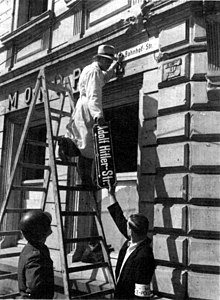
denazification
According to the Potsdam Agreement , German and Austrian society, culture, the press, the economy, jurisdiction and politics were to be freed from all the influences of National Socialism . This should be done in the context of comprehensive democratization and demilitarization .
There were five categories for dividing the population:
- Main culprits ( war criminals )
- Affected (activists, militarists, beneficiaries)
- Less burdened
- Fellow travelers
- Relieved
In the denazification processes in the western zones, many old Nazi party members got away with increasingly light injuries. Of all the Western allies, the Americans were the power most intent on denazification; however, they were ultimately able to do less and less against the widespread line-of-mind mentality among the German population. Also their own political goals - political "cleansing" vs. Consolidation of a market economy bastion against socialism - contradicted each other. In addition, highly sought-after specialists and experts in both West and East were often exempt from “denazification”.
In 1947, the trial of Nazi criminals from the Sachsenhausen concentration camp took place in the Soviet-occupied eastern zone ; At the same time, the Soviet Union continued to use the camp as special camp No. 7 Sachsenhausen for its own purposes, with former National Socialists as well as unpopular social democrats, liberals and conservatives being imprisoned. By 1949, 12,000 prisoners died here, u. a. the well-known film and theater actor Heinrich George . The camp remained the largest detention center in the Eastern Zone until 1950. There were internment camps in all zones.
By 1950, 3.66 million of the 6 million cases brought to justice in the Western Zones. Almost 1,700 people were classified as main culprits, 23,000 as suspects, 150,000 as minor suspects, one million as followers and 1.2 million innocent. In the east, 520,000 layoffs for political reasons had been made by March 1948.
In the spring of 1948, the “hot phase” of denazification came to an end in both the western and eastern zones.
Reeducation
A kind of denazification of public culture should in various occupied zones Reeducation afford: education about Nazism and the opposing goals of democracy, mediated for example, about literature, film, lectures and art exhibitions. It was based on a certain fear of the Allies that the Germans would be a people under the spell of “Nazi blindness”, and probably also the shock of the atrocities of the concentration and extermination camps . In fact, most Germans abandoned the Nazi ideology surprisingly quickly - if they had really believed in it until the last days of the war - and were more than enough preoccupied with their everyday problems. It was less clear whether superficial renunciation always meant deeper insight and real distancing from the Nazi era. The historian Norbert Frei even speaks of a “mentally […] still existing national community ” that would have survived into the 1960s despite democratic reforms and undoubtedly effective denazification caesuras (see also “ Coming to terms with the past ”). This has been said for the West German states - in East Germany there were other fault lines to the past due to the officially decreed anti-fascism , but also far-reaching authoritarian traditions.
Political re-education had initially set itself the goal of reforming the very hierarchical German education system (for example through the reform and laboratory school concept of John Dewey ). This was partially omitted and is the subject of controversy in education policy up to the present day.
After the war, which led Psychological Warfare Division of SHAEF a collective guilt by campaign: for example, with posters and films like " Death Mills ". The allied collective guilt directive was later repealed because it hampered the new goal of democratization.
Directive No. 1 from Robert A. McClure , head of the Information Control Division and specialist in psychological warfare , to the US Army Group Press explains the procedure:
"The first steps of re-education will be strictly limited to presenting the Germans with irrefutable facts in order to create an awareness of Germany's war guilt and collective guilt for such crimes as were committed in the concentration camps."
Party foundations in the zones of occupation
Efforts to rebuild democratic parties in Germany began as early as 1945. With only a few exceptions, they were worn by representatives of the former Weimar party system who had spent the years of National Socialism partly in exile and partly in Germany. The victorious powers exercised the most lasting influence because they held the power to govern. However, they had not made any detailed binding agreements on a common policy in Germany. Therefore, the individual occupying powers oriented themselves to the different international interests of their respective governments. As with economic policy, the victorious powers also pursued very different strategies in terms of political reorganization. The Soviet occupying power quickly allowed new parties to be founded. In August 1945 the Allies agreed at the Potsdam Conference that democratic political parties should be permitted throughout Germany. The American occupation authorities gave their permission in August, the British in September. France followed in December 1945.
The German communists were initially weakened by persecution and the Stalinist purge . Many German political forces tried to tie in with the democratic traditions of the Weimar Republic while avoiding the weaknesses of this system. Even in the more bourgeois parties, moderate forms of socialism were initially relied on and, above all, they were skeptical of the large-scale industry involved in the Nazi armaments apparatus (cf. Ahlen program of the CDU from 1947). The representatives of so-called ordoliberalism , important stimulators of the later social market economy in the Federal Republic, turned vehemently against cartels , monopolies and oligopolies ; the return to the German tradition of corporatism of the economy and the quick end of the Allied unbundling policy was not effectively prevented later, despite this teaching (see also Deutschland AG ).
On November 6, 1945, the state council of the US zone was constituted in Stuttgart. In January 1946, parties were re-admitted in American-occupied Bavaria, first the KPD, then the SPD, and finally the CSU and FDP .
In the first post-war elections in Bavaria (for the constituent assembly ), a royal and home party also stood, the KPD received a little more than five percent. Right-wing conservative parties also competed in the British zone. In 1945/46 Ludwig Erhard was Minister of Economic Affairs in Bavaria , later an important protagonist of the currency reform and market economy in the western zones and in the young Federal Republic, of which he became the second Federal Chancellor.
The SPD of the Western Zones under Schumacher was initially still against outright integration into the West , but was also anti-communist, even if the party still saw itself as Marxist. The aim was a neutral Germany between the blocs of capitalism and communism .
The KPD was initially looking for an anti-fascist alliance with bourgeois democratic forces. After the poor performance of the communists in elections in Austria and Hungary, however, they tried, with the support of the Soviet military government , to achieve a merger of the SPD and KPD throughout Germany. Kurt Schumacher clearly rejected this on behalf of the SPD in the three western zones of occupation; 82 percent of the West Berlin Social Democrats were against it in an internal party vote. The Soviet Union did not allow corresponding votes in its sphere of influence. In April 1946 the merger in the eastern sector was carried out under Soviet pressure.
In the first free elections in Berlin in 1947, the SPD received 49 percent of the vote, the merger party operating as the “ Socialist Unity Party of Germany ” only 20 percent. After that, the SED really shunned free elections, the other approved parties in the Soviet Zone ( LDPD u. A.) Were gradually brought into line and block parties . The SED finally became a cadre party around 1948 .
In October 1946, Stalin called the “western border of Poland final”.
In the meantime , the young Erich Honecker built up the organization of the Free German Youth (FDJ) from the eastern zone, which soon ousted Christian youth groups through socialist propaganda . At the end of 1947 the sector boundaries of Berlin were marked for the first time.
On February 25, 1947, the Allied Control Council passed the Control Council Act No. 46 to dissolve Prussia (" The root of all evil. " Churchill in Tehran 1943).
In January 1949, following the completion of the expulsion, Poland politically incorporated the former German eastern territories into its state administration (previously they were administered by a special ministry). De facto, they became part of Poland, de jure only in 1990.
Culture
literature
In the immediate post-war period in Germany after the Second World War , there was a confrontation between emigrants like Thomas Mann and the cultural protagonists of “inner emigration” ( Frank Thieß ). In literary circles - also because of the language manipulation of the National Socialists - called for a radical criticism of language and a "clear cut". The laconic American short stories found their way into German literature. In addition, tendencies of modern world literature were included that could not reach Germany during the Third Reich , such as psychoanalysis , Marxism , existentialism , surrealism and expressionism .
From the prisoner of war magazine “ Der Ruf ”, in which u. a. Alfred Andersch and Hans Werner Richter wrote, the group of writers “ Group 47 ” emerged. Wolfdietrich Schnurre and Günter Eich were among its early members . Elisabeth Langgässer was also a well-known writer in the immediate post-war period . In 1948 Hans Erich Nossack addressed the horrors of the bombing war based on the destruction of his hometown Hamburg.
In the Soviet Zone, “ Aufbau ” was launched early on as the first political and cultural magazine in post-war Germany. At first, non-Stalinist authors could also publish here. Johannes R. Becher , who was initially active in the association “ Kulturbund ” , quickly became a central figure in East Germany's cultural policy . Back in the SBZ returned u. a. the prominent exiles Anna Seghers (1947) and Arnold Zweig (1948), the philosopher Ernst Bloch and the playwright and poet Bert Brecht (both 1949).
Visual arts
In the visual arts in West Germany, artists ostracized as " degenerate " by the National Socialists were rehabilitated early on . B. Willi Baumeister , who comes from the Bauhaus tradition, was appointed art professor in Stuttgart (1946). In the West, efforts were made to follow the international trends in modern painting (abstraction, etc.). However, the outstanding importance of the German art scene before 1933 was not achieved again. There was an exhibition of modern art in the Berlin City Palace, which was not completely destroyed, and the painter Max Pechstein also taught in Berlin from 1947.
Music and theater
In 1947 the "denazified" Wilhelm Furtwängler was again allowed to conduct the Berlin Philharmonic - now in the Titania Palast . In the same year the Sartre play "The Flies" was performed in the Hebbel Theater. Gustaf Gründgens also staged again in Berlin. Political cabaret flourished after a long break in Germany. There were also operettas and revues in the Friedrichstadtpalast two years after the end of the war.
Movie
As the first German post-war film in 1946, the DEFA feature film “ The Murderers Are Among Us ”, u. a. with Hildegard Knef , premiere.
radio
Allied soldier broadcasters ( AFN etc.) had a considerable influence on the popular music tastes of young Germans. Jazz and swing , and later rock 'n' roll , became popular. In the British occupation zone, the NWDR was built on the model of the BBC : Instead of state propaganda, objective, independent reporting is to be broadcast.
In general, as the only mass medium accessible every day, radio once again played an important role in art - see, for example, Wolfgang Borchert's radio play “ Outside in front of the door ”. During this time, Berlin's Friedrich Luft became a well-known theater critic with his “ Voice of Criticism ” broadcast on the radio .
The way to the establishment of two German states
Creation of the bizone
The countries of the American and British zones decided to coordinate their administrations in September 1946. The US Secretary of State James F. Byrnes pointed out the need for economic unity in Germany. On January 1, 1947, the two zones were economically united to form a bizone.
The administrative rapprochement followed later, and the path to a "West German state" was mapped out. On May 29, 1947, an agreement was signed between the American and British military governments to set up a joint economic council.
At the conference of all prime ministers of the German states in Munich from June 6 to 8, 1947, Germany's economic distress was discussed. Above all, a regulation should be found to overcome the poor supply situation. The conference failed with the departure of the Prime Minister of the Soviet occupation zone on the eve of the conference, as the discussion of a German central government had been forbidden to the representatives of the French zone by the occupying power there. Around this time, the later State Council Chairman of the GDR, Walter Ulbricht , spoke in front of the Munich Feldherrnhalle and again called for the all-German introduction of the socialist system.
France joined the bizone with its zone of occupation in southwest Germany only hesitantly in 1948, which is how the trizone came into being . Karl Berbuer then wrote the song "We are the natives of Trizonesia".
In March 1948, the Soviet representatives left the Allied Control Council in protest against the London Six Power Conference , which finally lost its function. On June 16, 1948, the Soviet delegation also left the Allied headquarters in Berlin.
Currency reform
The currency reform of 1948 introduced the German mark on June 21, 1948 in the three western occupation zones of Germany. On June 20, each person received a "bounty" of 40 DM and a month later 20 DM was paid in cash.
In order not to be flooded by the remaining Reichsmarks from the western zones, a currency reform was also carried out in the Soviet occupation zone two days later, on June 23, 1948 . The Soviet regime forbade the use of the new western currency and wanted to expand the newly introduced currency to all of Berlin. The Western powers declared this order invalid in West Berlin and introduced the D-Mark there on June 24th.
Berlin blockade and airlift
In protest against the introduction of the DM in West Berlin, the Soviet Union cut off all land and water connections between the Western Allied occupation zones and West Berlin for freight traffic on June 24, 1948. Only the air corridors remained open. Passenger traffic was not affected. The Americans and British then supplied the city from the air, and soon a transport plane landed every two minutes in the western sector, most of them at Tempelhof Airport . Modern radar technology made the close timing possible. Nevertheless, more than 70 machines crashed in the course of the action.
In this situation, the West Berliners and the West Germans saw the “Ami” (Americans) and “Tommy” (British) less and less as occupiers than as friendly powers.
On September 9, 1948, Ernst Reuter (SPD) gave his famous Berlin speech (“ You peoples of the world, look at this city! ”) At the Brandenburg Gate in front of 250,000 to 300,000 people. On November 30th the Soviet administration declared the Berlin magistrate to be deposed, so there were free elections on December 5th only in the western sectors of Berlin. Ernst Reuter was elected mayor after the Soviet administration delayed his assumption of office for 1½ years.
On May 12, 1949, the Berlin blockade was lifted after eleven months.
Foundation of the Federal Republic of Germany
On July 1, 1948, the Western Powers handed over the Frankfurt Documents to the Prime Ministers of the Western Zones , calling for the formation of a constituent assembly. At the Rittersturz conference in July 1948, the heads of government of the twelve West German states decided to found the Federal Republic of Germany. At the Constitutional Convention on Herrenchiemsee , a committee of experts on constitutional issues discussed the basis for the work of the Parliamentary Council . This met on September 1, 1948 in Bonn and there drafted the Basic Law for the Federal Republic of Germany , which came into force on May 23, 1949; Through this the new form of government of a Federal Republic was established as a contentious democracy on the foundation of the free democratic basic order . The first federal election took place on August 14, 1949 . On September 7, 1949, the Federal Council and the Bundestag were constituted .
A completely sovereign German (partial) state did not yet exist: Foreign policy, foreign trade and other departments were initially still under Allied control. A parliamentary democracy emerged . The following applied to the new constitution and the political framework:
"In terms of content [...] the Basic Law shows through its open character and, above all, the fact that it was really politically accepted by all relevant groups - unlike the Weimar Constitution - an essential piece of reorganization through which every sweeping contemporary and later restoration criticism is emphatically questioned. "
Foundation of the GDR
On October 7, 1949, a torchlight procession took place on the occasion of the founding of the German Democratic Republic . Wilhelm Pieck became president of the new state. A so-called people 's democracy emerged .
Quotes
"The German people must be convinced that they have suffered a total military defeat and that they cannot evade responsibility for what they themselves have incurred as a result [...]."
"You have to do with German fate and German guilt when you are born German."
“If you work with the utmost dedication and do not allow yourself to be misled by serious disappointments, you will probably be able to tell some people in today's Germany what should be preserved through the historical night. There is hardly a place that is more important than Germany. "
Additional information
See also
- Occupied post-war Austria
- German war invalids in the 20th century
- History of German countries , chronicle of the division of Germany , Cominform
- University in the post-war period (1945–1951)
- Reparation
Movie
- Germany - Made in USA. How US agents steered post-war Germany. Documentation, Germany, 45 min, 1999 Director:. Joachim Schröder, Production: WDR May 26, 1999 (: -Nachtkultur, Episode Synopsis ( Memento of 25 December 2004 at the Internet Archive ) WDR)
literature
- Federal Archives and Institute for Contemporary History (Hg): Files on the prehistory of the Federal Republic of Germany 1945–1949 , ISBN 3-486-52641-3 .
- Wolfgang Benz : Potsdam 1945. Occupation and rebuilding in four-zone Germany . dtv, Munich 2012, ISBN 3-423-04522-1 .
- Bavarian State Center for Political Education : 30 years of the Federal Republic . 3 volumes, Munich.
- Christoph Brüll: Belgium in post-war Germany. Occupation, rapprochement, compensation 1945–1958 . Klartext , Essen 2009, ISBN 978-3-8375-0252-7 .
- Camilo Erlichman, Christopher Knowles (Eds.): Transforming Occupation in the Western Zones of Germany. Politics, Everyday Life and Social Interactions, 1945–55 . Bloomsbury Academic, London 2018, ISBN 978-1-3500-4922-2 .
- Bruno Gebhardt (Welcoming), Herbert Grundmann (Ed.): Handbook of German history . Volume 22, 1: Wolfgang Benz : 20th Century (1918–2000). Germany under Allied occupation, 1945–1949 . 10., completely reworked. Ed., Klett-Cotta, Stuttgart 2009, ISBN 978-3-608-60022-3 .
- Christoph Kleßmann : The double founding of the state. German history 1945–1955 . Vandenhoeck & Ruprecht, Göttingen 1982, ISBN 3-525-36180-7 .
- Lutz Niethammer : Was civil society in Germany at the end or at the beginning in 1945? In: Lutz Niethammer u. a .: Civil society in Germany. Historical insights, questions, perspectives . Fischer-Taschenbuch-Verlag, Frankfurt am Main 1990, ISBN 3-596-24387-4 ( Fischer 4387 history ).
- Manfred Raether: Chronicle of an exchange of letters. 1944-1949. Contemporary history as reflected in a correspondence marked by war, flight and separation . M. Raether, Schöneck 2008, ISBN 978-3-00-024063-8 .
- Heinrich Siegler: Documentation on the German question . Siegler & Co. KG - Verlag für Zeitarchive, Bonn 1961.
- Heinrich August Winkler : Setting the political course in post-war Germany 1945–1953 . Vandenhoeck & Ruprecht, Göttingen 1979, ISBN 3-525-36404-0 .
- Michael Schwartz : Displaced Persons and “Resettlement Policy”. Integration conflicts in post-war German societies and assimilation strategies in the Soviet Zone / GDR 1945–1961. Publications on SBZ / GDR research in the Institute for Contemporary History, Sources and Representations on Contemporary History, Volume 61, Munich 2004, ISBN 978-3-486-56845-5 .
Web links
- Germany after 1945 (bpb)
- Post-war period at the German Historical Museum
- on the "migration movements" of the post-war period
- The German automotive industry in 1948 ( Memento from April 27, 2001 in the Internet Archive )
- Volkswagen 1940–1949 ( Memento from August 13, 2010 in the Internet Archive )
- on the subject of re-education (Shoa.de e.V.)
- further keywords on re-education ( memento from September 24, 2005 in the Internet Archive )
- Post-war literature (www.literaturwelt.com)
- Roosevelt Documents January – September 1944 , October 1944–1945 (English)
- Morgenthau Plan (English)
- Interview with E. Allan Lightner, 1945–1948 Vice-Head of the Department for Central European Affairs in the Department of State
- Draft, The President's Economic Mission to Germany and Austria, Report 3, March, 1947; OF 950B: Economic Mission as to Food…; Truman Papers.
- JCS 1067 (PDF file; 73 kB)
- Herbert Hoover's press release of The President's Economic Mission to Germany and Austria, Report No. 1: German Agriculture and Food Requirements, February 28, 1947
- Kindleberger to de Wilde, March 24, 1947; Memoranda, 1947; State Department File; Charles P. Kindleberger Papers.
- Kindleberger to deWilde, April 18, 1947; Memoranda, 1947; State Department File; Charles P. Kindleberger Papers.
- The Stuttgart speech by US Secretary of State James F. Byrnes on September 6, 1946; explains the separation of the Saarland ( Memento from September 12, 2007 in the Internet Archive )
- End of the war (document collection)
- Scientific conference on the Allied occupation (English)
- State Institute for School Quality and Teacher Training Saxony-Anhalt (Ed.): Bibliographical handout on German-German contemporary history / 1. Starting situation 1945 and occupation time, work status: December 31, 2013
Dismantling
- “Der Berg des Elends” , Süddeutsche Zeitung, November 19, 1946
- Disassembly list for 1947
- Anti-dismantling demonstration, June 7, 1949 (Fig.)
- Dismantling of the coal and iron works (Fig.)
- "Demontage" , Die Welt, October 11, 1947
- "For a disaster" , Der Spiegel from August 25, 1949
- Aide-mémoire from Konrad Adenauer to the Allied High Commission (November 16, 1950)
expulsion
- expulsion
- "Refugees - Without Hope" , Die Welt, October 25, 1947
- Camp in 1950 (Fig.)
- Barbara Liebig: The admission of refugees and displaced persons as well as aspects and efforts of their inclusion / integration in the district of Salzwedel 1945 to 1948/49 , Diss., Univ. Magdeburg, 2005
Remarks
- ↑ After the Second World War, the victorious powers banned all previous national flags .
- ↑ In fact, in the defeated enemy state (according to the US-American Directive of Occupation JCS 1067 ) there were only the flags of the occupiers in the respective zones / sectors. By resolution of the Allies, German ships had to carry the standard C of the signal flag alphabet from 1945 onwards . “C” stood for “ Capitulation ” and was set with humiliating intent. Costa Rica objected because it has a similar distinctive symbol as its national flag . So the stand C was cut at right angles at the flying end. After the two German states were founded in 1949, this practice ceased.
Individual evidence
- ↑ Several different time models up to 1949, on this Christoph Drösser: Was there a time change of two hours in the post-war period? Zeit Online , March 22, 2018, accessed January 24, 2020 .
- ^ The Saarland State Parliament: The Saarland after 1945 ( memento from June 6, 2009 in the Internet Archive ), accessed on October 1, 2015.
- ↑ Foreign relations of the United States: diplomatic papers: the Conference of Berlin (the Potsdam Conference) , 1945 1 , 2
- ↑ Jonas Tjersland, Tyske soldater brukt som mineryddere , VG, April 8th of 2006.
- ^ Staff, ICRC in WW II: German prisoners of war in Allied hands , February 2, 2005.
- ↑ Forced labor as a mine clearer - "Rudi was totally riddled with holes " , in: one day of August 27, 2008, Der Spiegel 35/2008.
- ↑ Christa Schleich: The rubble women of the forest
- ↑ See also Rosemarie Nemitz, The woman in the German parliaments , in: trade union monthly magazines , vol. 9, 1958, issue 4, pp. 239–244, here p. 242; Gabriele Bremme, The Political Role of Women in Germany. A study of the influence of women in elections and their participation in party and parliament , Göttingen 1956, p. 131.
- ↑ Note: Food relief shipments to Germany were prohibited by the Allies until December 1945, since "they might tend to negate the policy of restricting the German standard of living to the average of the surrounding European nations. CARE package shipments to individuals remained prohibited until 5 June 1946 “ ( Earl F. Ziemke, The US Army. In The Occupation of Germany 1944-1946 , footnote on chap. 23).
- ↑ James L. Payne: Did the United States Create Democracy in Germany? In: The Independent Review Volume 11 Number 2 Fall 2006. p. 213.
- ↑ http://germanhistorydocs.ghi-dc.org/docpage.cfm?docpage_id=3403
- ↑ Potsdam Reparations begin , General, p. 13 f. (PDF; 984 kB)
- ↑ Henry C. Wallich , Main Springs of the German Revival , 1955, pp 348 et seq.
- ↑ Gerhard Stapelfeldt, Economy and Society of the Federal Republic of Germany , 1998, p. 180.
- ↑ German-American Center - James F. Byrnes Institute e. V. ( Memento from July 21, 2010 in the Internet Archive )
- ↑ Post-war semester: Studies in the war and post-war period , p. 85.
- ^ Lewis H. Brown: A Report on Germany , New York 1947, p. 81.
- ↑ Quoted from Peter Graf von Kielmannsegg: After the catastrophe. A history of divided Germany , Berlin 2000, ISBN 3-88680-329-5 , p. 36.
- ↑ Reinhold Nimptsch: “Productive refugee aid from the trade unions: New organizational methods for the construction of 10,000 apartments”; Cologne 1950
- ↑ Astrid Holz, Dietmar Walberg, et al: Settlements from the 1950s - modernization or demolition? Methodology for making decisions about demolition, modernization or new construction in settlements from the 1950s. Final report. Federal Office for Building and Regional Planning -BBR-, Bonn (sponsor); Working group for contemporary building e. V., Kiel (executive body); Construction Research Report No. 56; Kiel 2006. ISBN 978-3-8167-7481-5
- ↑ Working group for contemporary building e. V. (Eds.): Johannes Scharre / Ulrich Haake: "The construction of 10,000 refugee apartments in Schleswig-Holstein (ERP special program 1950) - results, methods, experiences and conclusions", / Arbeitsgemeinschaft für Produktiv refugeeshilfe e. V .; (Research report on behalf of the Federal Ministry for Housing No. 148 (2404/05)); Building research report of the working group for contemporary building e. V. No. 2, Kiel 1952
- ↑ David R. Henderson: German Economic "Miracle"
- ^ Norman M. Naimark, The Russians in Germany , pp. 206 ff.
- ↑ How T-Force abducted Germany's best brains for Britain - Secret papers reveal post-war campaign to loot military and commercial assets , Ian Cobain, The Guardian , August 29, 2007.
- ↑ Konrad Adenauer, Memories , Vol. 1. Memories 1945–1953 , engl. Edition 1966, p. 148.
- ↑ Jean Edward Smith, Feature Review: American Exploitation of Postwar Germany , Diplomatic History, Vol. 17 Issue 1, pp. 135-142.
- ↑ Konrad Adenauer, Memoirs , Vol. 1, 1966, p. 148.
- ^ A b John Gimbel, US Policy and German Scientists: The Early Cold War , Political Science Quarterly, Vol. 101, No. 3, (1986), pp. 433-451.
- ^ A b Ivan Hirst - Englishman who made Volkswagen part of the German economic miracle . The Guardian. Retrieved September 30, 2010.
- ↑ Reconstruction and development in the four zones 1945–1949 , Konrad-Adenauer-Stiftung , accessed on January 30, 2017.
- ↑ Volker Bode: War Destruction and Reconstruction of German Cities after 1945 , in: Leibniz Institute for Länderkunde (Ed.): National Atlas Federal Republic of Germany , Vol. 5, pp. 88–91.
- ↑ Klaus Jochen Arnold: Dismantling in the Soviet Occupation Zone and Berlin 1945 to 1948. Subject inventory ( Memento from February 7, 2013 in the Internet Archive ), Brandenburgisches Landeshauptarchiv, Zentrum für Zeithistorische Forschung, Potsdam 2007.
- ^ Elke Kimmel: Postwar Situation in the Soviet Zone / GDR , bpb , October 31, 2005.
- ^ Philipp Ther: German and Polish expellees. Society and policy of expellees in the Soviet occupation zone / GDR and in Poland 1945–1956 (= Critical Studies on History , Vol. 127). Vandenhoeck & Ruprecht, Göttingen 1998, ISBN 3-525-35790-7 , p. 44 f.
- ↑ Figures from: Germany 1945–1949 , Information on Political Education No. 259, bpb, 1998.
- ↑ Uta Bretschneider: Resettlers (SBZ / GDR) , online encyclopedia on the culture and history of Germans in Eastern Europe, University of Oldenburg, 2013.
- ^ Michael Schwartz: Staatsfeind Umsiedler , Der Spiegel , June 1, 2002; Philipp Ther : Displaced persons policy in the Soviet occupation zone and the GDR 1945 to 1953. Friedrich-Ebert-Stiftung , Netz-Quelle history and politics.
- ^ Michael Schwartz: Displaced persons problem and resettlement policy in the Soviet Zone / GDR. PDF ( Memento of February 21, 2007 in the Internet Archive ), Friedrich-Ebert-Stiftung; Torsten Mehlhase: First efforts to integrate the refugees and expellees in Saxony-Anhalt from 1945 to 1949 with special consideration of the Sudeten Germans. In: Bohemia , Vol. 33, 1992, pp. 338-353 ( digitized version ).
- ↑ Michael Schwartz: From 'Refugee' to New Citizen. Integration of displaced persons as a socio-political problem in German post-war societies ( Memento from July 30, 2017 in the Internet Archive ). Documentation of the conference: border and border residents. Neighbors and strangers. Old home - new home. Farewell and arrival. 2-4 December 1994, Guben / Gubin. Published in: Transodra. No. 10/11, April 1995, pp. 26-39.
- ^ Justus Fürstenau: Denazification. A chapter of German post-war politics . Neuwied 1969, p. 228 f.
- ↑ Jeffrey K. Olick: In the House of the Hangman: The Agonies of German Defeat, 1943-1949. The University of Chicago Press, Chicago, London 2005, p. 98 f. ( Footnote 12 ).
- ↑ Jeffrey K. Olick: In the House of the Hangman: The Agonies of German Defeat, 1943-1949. The University of Chicago Press, Chicago, London 2005, p. 98 f. ( Footnote 12 ).
- ↑ Constanze Kutschker, Debora Landau: A founding dilemma of the German culture of remembrance: The Gardelegen massacre on April 13, 1945 and its consequences Forum Ritualdynamik, No. 10, March 2005 ( PDF; 2.3 MB ).

